What is gamma adjustment?

1.The color contrast is adjustable.
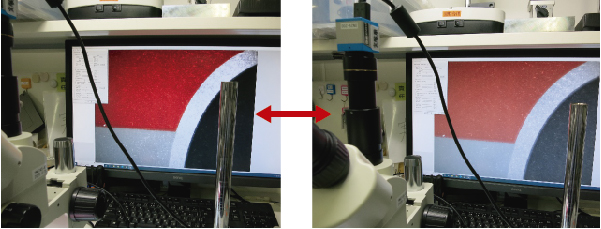
2.It can reduce reflections and blackouts. (HDR-like video effects)
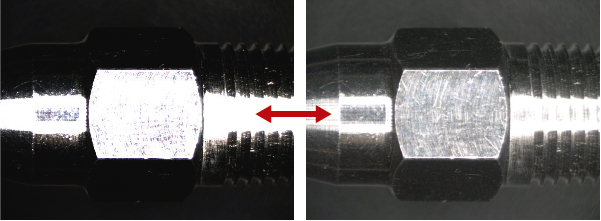
What is gamma adjustment?

1.The color contrast is adjustable.

2.It can reduce reflections and blackouts. (HDR-like video effects)

Number of pixels: 20 million pixels (resolution 5472×3648)
Pixel size: 2.4μm×2.4μm
Sensor Size: 1 inch
Shutter method: Rolling shutter
The IMX226 has a pixel size of 1.85×1.85 μm and uses a rolling shutter method.
SONY’s Pregius series is characterized by high sensitivity and low noise performance. The sensor is 1/1.7″ in size and is available with standard and affordable 2/3″ C-mount lenses.
Number of pixels: 12 million pixels (resolution 4000×3036)
Pixel size: 1.85μm×1.85μm
Sensor size: 1/1.7 inch
Shutter method: Rolling shutter
Includes a polarizing filter to reduce halation!
The IMX178 is a rolling shutter sensor with a pixel size of 2.4×2.4 μm.
SONY’s Starvis series supports high sensitivity even in low-light environments by increasing the gain. The sensor has a resolution of 6 million pixels, a size of 1/1.8 inch, and a wide dynamic range, making it suitable for a variety of applications.
Number of pixels: 6 million pixels (resolution 3072 x 2048)
Pixel size: 2.4×2.4µm
Sensor size: 1/1.8 inch
Shutter method: Rolling shutter method
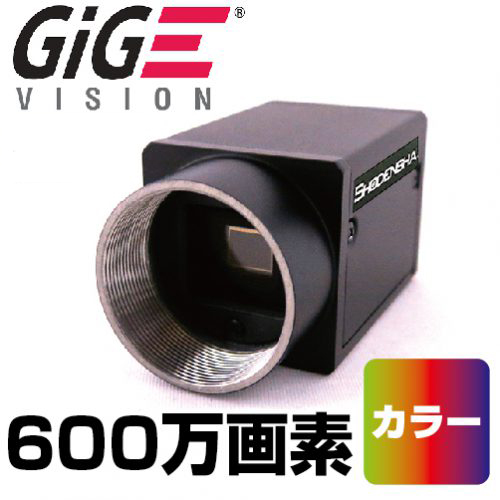 |
GigE camera (6 million pixels, color) EG600U-C
|
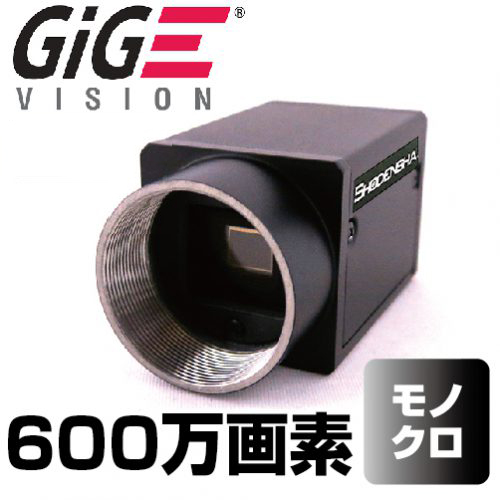 |
GigE camera (6 million pixels, monochrome) EG600U-B
|
The IMX264 has a pixel size of 3.45×3.45 μm and the sensor uses a global shutter method. The Pregius series manufactured by SONY is characterized by high sensitivity and low noise performance. This sensor is 2/3 inch in size, has a wide dynamic range, and has a resolution of 5 million pixels, making it suitable for a variety of applications.
Number of pixels: 5 million pixels (resolution: 2448 x 2048)
Pixel size: 3.45×3.45µm
Sensor size: 2/3 inch
Shutter method: Global shutter
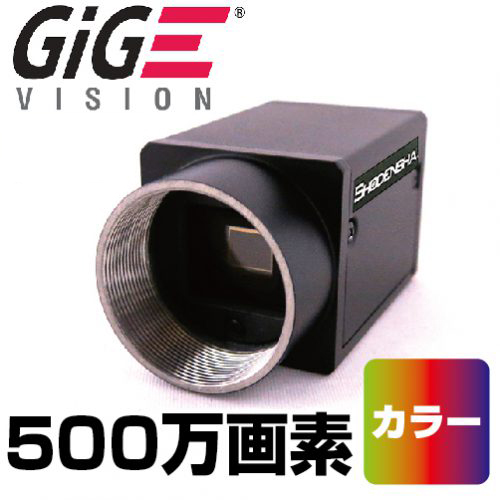 |
GigE camera (Sony 5 million pixels, color) EG501-C
|
 |
GigE camera (Sony 5 million pixels, monochrome) EG500-B
|
At this price, it can be used overseas with double LED arrangement and light intensity increase 100 ~ 240V.
● Control box separate type. It is convenient because it can be dimmed at hand.
● Diffusion plate is standard equipment
● 56 LEDs are double-arranged to increase the amount of light
● Can be attached to microscopes, microscopes,…
● The body is a robust metal case. Good heat dissipation efficiency
Many industrial cameras have external trigger terminals.
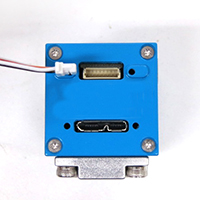 |
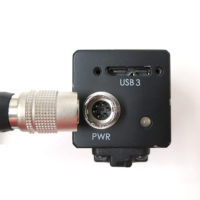 |
| USB Camera DN Series | USB Camera CS Series |
This trigger pin is used to control the timing of still image shooting and video recording with a sensor or PLC (programmable logic controller).
Watch the video brief image below.
Of course, even if you don’t use an external trigger, you can use the included application software to save still images and record videos.
However, in actual production lines, it is common to shoot and record at the timing of the object to be photographed, and there are many situations where an external trigger terminal of an industrial camera is required.
Watch the video brief image below.
When using external trigger terminals, there are various ways to use them depending on the customer’s production line.
In addition to simply saving still images and recording videos, it can be used for a variety of purposes, such as recording videos before and after a problem occurs, or shooting and recording with multiple cameras.
Therefore, when using an external trigger pin, it is basically assumed that the customer will program it himself.
Industrial cameras usually come with an SDK (Software Development Kit) for development, which is used to create programs.
I mentioned that “basically create a program”, but if it is a simple function, application software can be used.
By using it, you can build a system without any knowledge of programming.
Among them, we will explain the most basic “saving still images with an external trigger”.
Even with the simple function of “saving one still image when an external trigger signal is input”, there are two main methods.
And the time display between the trigger and the next trigger is different.
(1) A still image taken with the latest trigger is displayed between the trigger and the next trigger.
・Saved images can be reliably checked in real time.
Even lines with movement can be visually checked using still images.
・When shooting with multiple cameras at the same time, it is possible to shoot perfectly in sync.
We offer the following software:
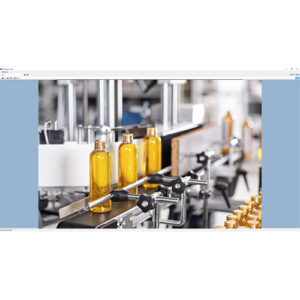 |
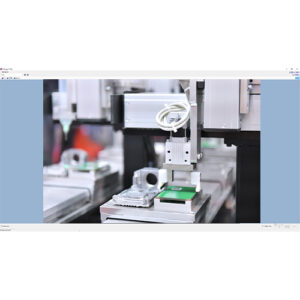 |
|
Trigger Shooting Software Hi TriggerF Light |
High-performance trigger shooting software Hi TriggerF Pro |
(2) A method is adopted in which live video is displayed between the trigger and the next trigger.
・Since the live image is always displayed, it is possible to monitor the status of lines other than the object.
・When shooting with multiple cameras at the same time, multiple frames may be out of alignment.
We offer the following software:
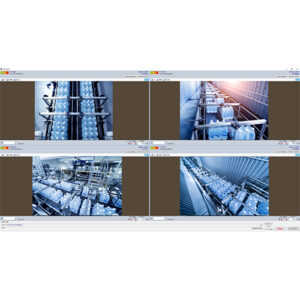 |
|
Four-screen display shooting software Hi TriggerQ |
In the case of video recording, there are the following two types.
(1) Use the start trigger and stop trigger as triggers
(2) Use only the start trigger as a trigger
In the case of (1), only a simple recording function is provided.
In the case of (2), various functions are available.
In addition to simply recording the specified time by timer control from the trigger, you can also record before and after the trigger (operation like a drive recorder). It is useful for event analysis when a problem occurs.
We offer video recording software that allows you to use both Start/Stop triggers, timers, etc.
 |
|
Long-Duration Recording Software Hi TriggerRec |
Software to record video before and after the trigger
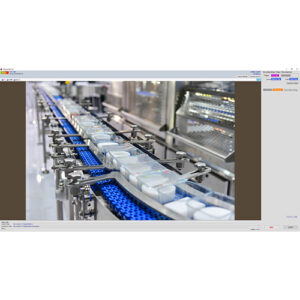 |
|
Facility monitoring drive recorder Hi TriggerWatcher |
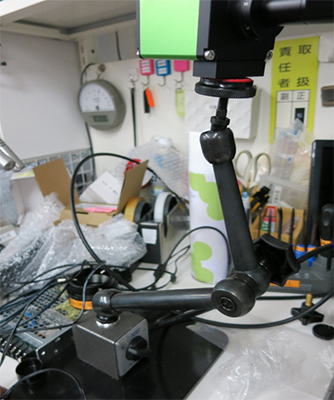
A 5.5Kg base is attached to a post and horizontal bar.
The base acts as a weight, so the horizontal bar is stable even if it is long.
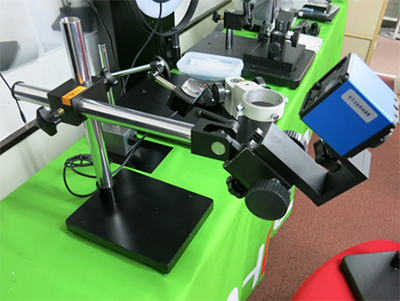
Horizontal bars on edge-fixed posts
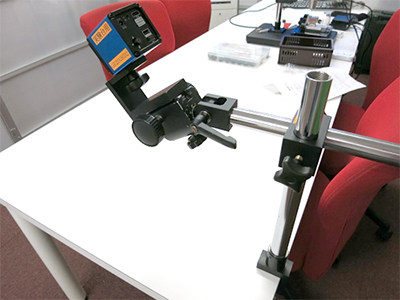
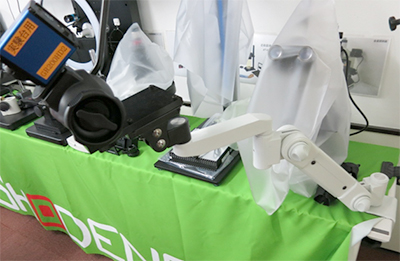
We introduce a small camera stand that is convenient for carrying around.
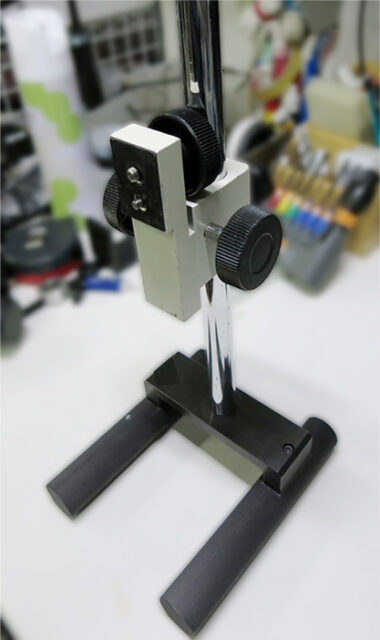
Before assembly, it looks like the following.
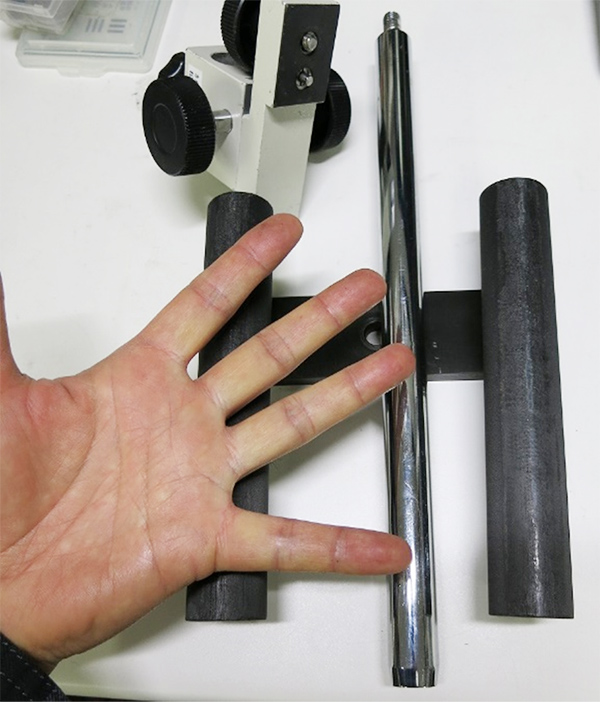
The following image is shown when the borescope camera system is installed.
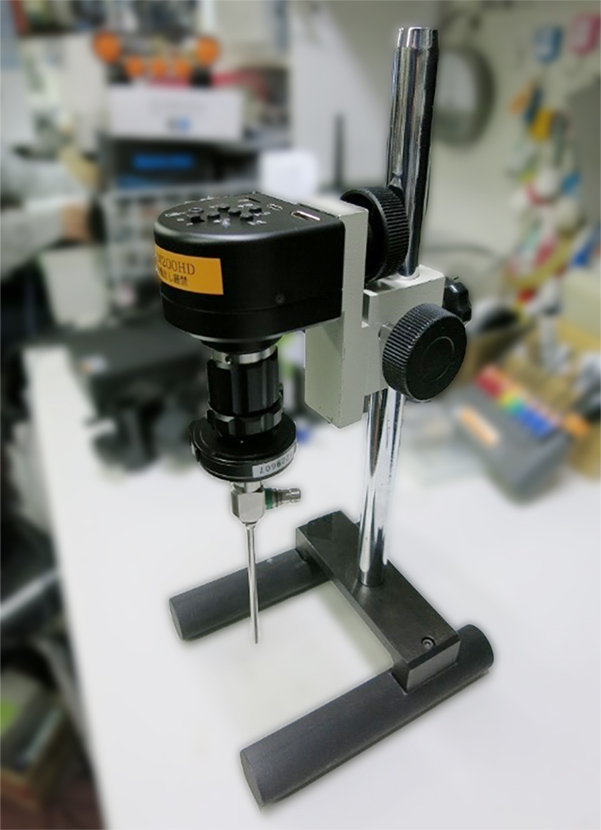
We can also manufacture custom stands to meet your needs.
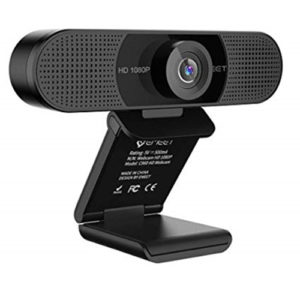
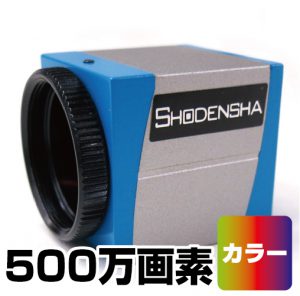
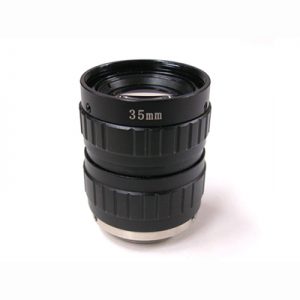
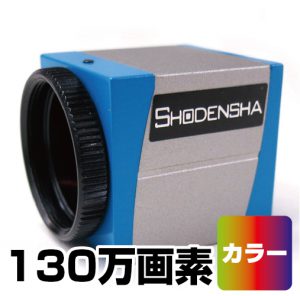
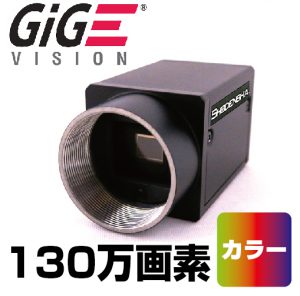
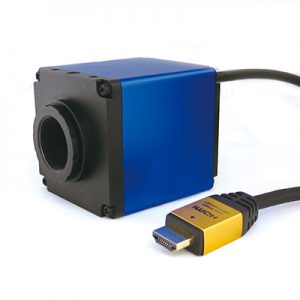


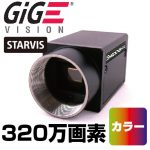
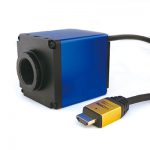
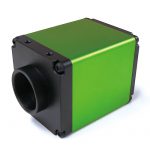
The pixel size of this IMX265 is 3.45 x 3.45μm, and it is a global shutter type sensor.
Sony’s Pregius series is known for its high sensitivity and low noise.
The resolution is 3.2 million pixels and the sensor size is 1/1.8 inch, so there are many lens options. It can be said that this model has a good balance between image quality and frame rate (speed).
Number of pixels: 3.2 million pixels (resolution: 2048 x 1536)
Pixel size: 3.45×3.45µm
Sensor size: 1/1.8 inch
Shutter method: Global shutter method
GigE camera (Sony 3.2 million pixels, color) EG320-C |
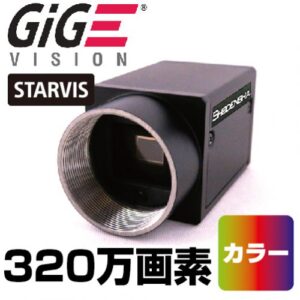 |
GigE camera (Sony 3.2 million pixels, monochrome) EG320-B |
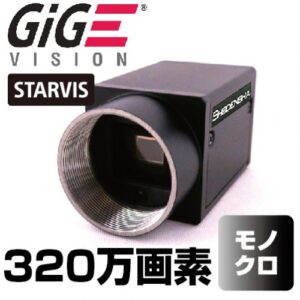 |
Number of pixels: 400,000 pixels (resolution 720 x 540)
Pixel size: 6.9×6.9μm
Sensor size: 1/2.9 inch
Shutter method: Global shutter method

According to USB cable standards, the maximum connection distance between devices is usually 5 meters. However, by using this “USB cable with repeater function”, you can connect devices with a cable longer than 5m. The product in the photo can be extended up to 12m using this cable.
This cable has a built-in signal amplification correction circuit. This circuit compensates for signal attenuation and allows cable extension. This cable can be extended over 12m. In that case, wire as shown below.
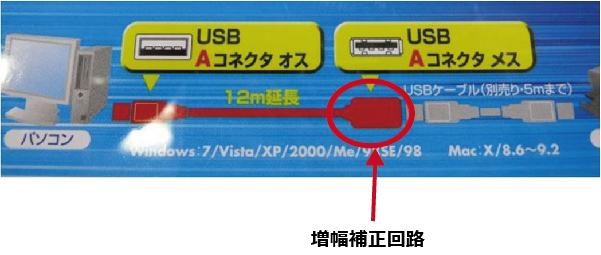
If you want to use multiple cameras, you need a high-performance PC. (The use of laptops is not guaranteed.) In general, as the resolution and number of cameras increase, so do the required specifications of the PC. The following are recommended specs, but this is a guide.
・CPU: 12th generation or later Intel Core i7 (12th generation or later Intel Core i9 is recommended for 4 or more cameras)
・RAM: 16 GB or more
If you’re recording for a long time, add the above specs to a GPU like the RTX 3070.
If you have more than 4 cameras, we recommend adding a USB board or a LAN board for GigE cameras to account for bandwidth limitations. To add a board, the required PCIe slot must be free.
Also, the amount of storage space you need depends on your camera’s resolution, fps, and recording time. The following is an estimate of the storage time that can be stored on each camera when using 1TB of storage.
1TB SSD
| 400,000 pixels 30fps | Compression | 160h |
| Non – compression | 6h45min | |
| 1.3 million pixels 30fps | Compression | 48h |
| Non – compression | 2h | |
| 5 million pixels 30fps | Compression | 11h |
| Non – compression | 28min |
※If there are 2 cameras, the time will be 1/2, and if there are 4 cameras, the time will be 1/4. When performing compressed recording, it may be possible to secure sufficient writing speed with an HDD depending on the number of cameras and fps.
When recording with multiple cameras at the same time, there may be a deviation of several frames between cameras due to factors such as camera clock and component deviations, aging, and the ambient temperature at which they are used.
Due to the complex interplay of these factors, it is difficult to give a specific amount of deviation, but as a general guideline, if you record for more than 8 hours, there may be a deviation of about 1 to 2 seconds.
Synchronous recording is a method that completely eliminates the above deviations and makes recordings without deviations. Synchronous recording uses not only a camera, but also a synchronous signal generator.
Multiple cameras are fed into the signal from the synchronous signal generator at exactly the same time, and only the frame at the time when the signal is entered is recorded, resulting in perfectly synchronized recording and not being affected by the camera clock or environment.
Due to space constraints, it may be necessary to configure the camera and lens in a compact manner.
In such cases, compactness can be achieved by choosing an S-mount lens that is smaller than a C-mount or CS-mount lens.
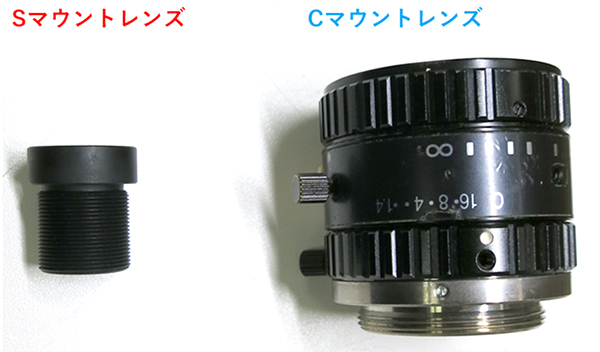
In order to use S-mount lenses, you need to attach a conversion adapter to the camera.
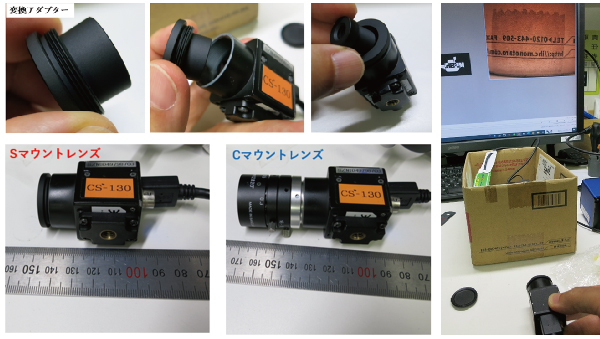
However, there is a caveat.
With S-mount lenses, the focus is adjusted depending on how well it is inserted into the camera.
Cameras usually have an infrared cut filter or a protective filter in front of the sensor.
In some cameras, the distance between the filter and the lens mount is close, and the lens may interfere with the filter when focusing, resulting in a lack of focus.

It is necessary to actually try and check whether the S-mount lens can be attached and used with the camera.
When using the same lens, the smaller the size of the image sensor, the narrower the field of view. In addition, the size of the image sensor is a necessary factor in the calculation of the field of view and the selection of the lens. (More on this later.)
The size of a single pixel can also be calculated from the size of the image sensor
For example, if the image sensor size of 1.3 million pixels (1280 dots × 1024 dots) is 1/2.5 inch, the horizontal orientation is 5.6 mm and the vertical direction is 4.2 mm.
In this case
Horizontal 5.6mm/1280dot=0.0044mm/dot
Vertical direction is 4.2 mm/1024 dot = 0.0041 mm/dot.
4:3 horizontal and vertical image sensor
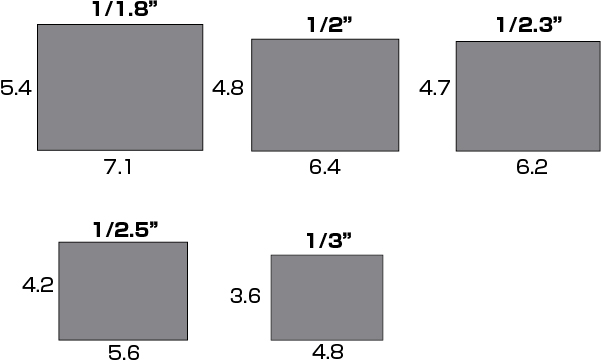
19:6 horizontal and vertical image sensor

When choosing a lens or calculating the distance to an object, the size of the image sensor is required.
The following factors are required to calculate the required lens based on the size of the object: the size of the camera’s image sensor and the distance to the object (W.D.).
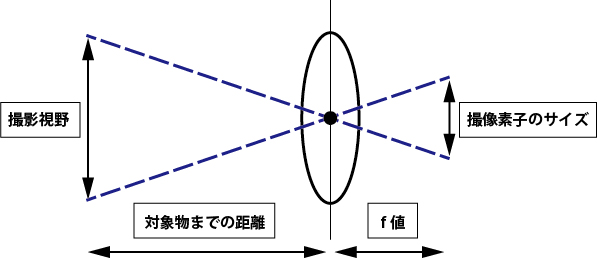
For example, if the distance to the object is 1 meter and the vertical field of view is 300 mm, what focal length lens should you choose? (Let’s assume we use a 1/2 inch camera).
The image sensor size of a 1/2 inch camera is as follows.

Focal length (f) = (distance to object (mm) x vertical size of image sensor (mm)) / vertical field of view = (1000mm x 4.8mm) / 300mm = 16mm
Therefore, choosing a lens with a focal length of 16mm will ensure the desired vertical field of view. Horizontal field of view can be calculated similarly.
Note that once you know the vertical or horizontal field of view, you can easily calculate the other field of view. A square image sensor has an aspect ratio of 4:3, so in the above case, the horizontal field of view is 300mm x 4/3 = 400mm.
Lenses that magnify objects often have a fixed focal length.
In this case, the characteristics of the lens cannot be expressed by the focal length (f value).
In the case of microlenses, performance is expressed in terms of optical magnification.
With a lens with an optical magnification of 1x, the field of view you want to observe matches the size of the image sensor.
For example, the size of a 1/3 inch image sensor is 4.8 mm x 3.6 mm, and the size of a 1/2 inch image sensor is 6.4 mm x 4.8 mm. We would appreciate it if you could check the specifications of our macro lenses based on this information.
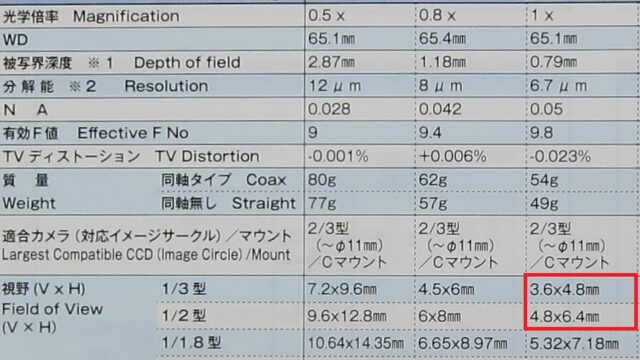
| USB camera CS series | USB camera DN series | GigE camera | |
| 1/1.1 inch |
CS1200-GC (12 million pixels, color)/ CS1200-GB (12 million pixels, monochrome) |
EG1200-GC (12 million pixels, color)/ EG1200-GB (12 million pixels, monochrome) |
|
| 1/1.7 inch |
CS1200-C (12 million pixels, color)/ CS1200-B (12 million pixels, monochrome) |
EG1200-C (12 million pixels, color)/ EG1200-B (12 million pixels, monochrome) |
|
| 1/1.8 inch |
DN3RG-130 (1.3 million pixels, color)/ DN3RG-200 (2 million pixels, color)/ |
EG320-C (3.2 million pixels, color)/ EG320-B (3.2 million pixels, monochrome) EG600U-C (6 million pixels, color)/ EG600U-B (6 million pixels, monochrome) |
|
| 1/2.3 inch | DN3R-1000 (10 million pixels, color) | ||
| 1/2.5 inch | CS500-C (5 million pixels, color)/ CS500-B (5 million pixels, monochrome) |
DN3R-500 (5 million pixels, color) | |
| 1/2.9 inch |
CS41-C (400,000 pixels, color)/ CS41-B (400,000 pixels, monochrome) |
EG41-C (400,000 pixels, color)/ EG41-B (400,000 pixels, monochrome) |
|
| 1/2 inch |
CS130U-C (1.3 million pixels, color)/ CS130U-B (1.3 million pixels, monochrome) CS500U-GC (5 million pixels, color)/ CS500U-GB (5 million pixels, monochrome) |
EG130U-C (1.3 million pixels, color)/ EG130-B (1.3 million pixels, monochrome) |
|
| 1 inch |
CS2000-C (20 million pixels, color)/ CS2000-B (20 million pixels, monochrome) |
EG2000-C (20 million pixels, color)/ EG2000-B (20 million pixels, monochrome) |
|
| 2/3 inch |
EG501-C (5 million pixels, color)/ EG500-B (5 million pixels, monochrome) |
Summary
The size of the image sensor is information necessary for calculating the field of view and selecting a lens. For CCTV lenses, use the following formula when calculating the lens for the desired vertical field of view:
f value = (distance to object (mm) x vertical size of image sensor (mm)) / vertical field of view
For macro lenses, the size of the image sensor is used to calculate the total magnification that will ultimately be displayed on the monitor.
The “flicker phenomenon” refers to a phenomenon in which abnormalities such as “light and dark fluctuations” and “color tone shifts” appear in images captured by a camera, although they cannot be detected with the naked eye.
In this article, we will introduce “What is the Flicker Phenomenon” and “How to Mitigate the Flicker Phenomenon”.
Some lighting devices flash to match the power frequency, while others pulse as a dimming system.
Although the flashing of light cannot be felt with the naked eye, if the shutter speed of the camera is faster than the blinking cycle, abnormalities such as “light and dark fluctuations” and “color tone shifts” will occur in the captured image. This is the flicker phenomenon.
The flicker phenomenon occurs under lighting such as fluorescent lamps that emit periodic light, and does not occur under direct current lighting.
There are two main symptoms of flicker.
In a camera with a global shutter system, the entire image periodically repeats fluctuations in brightness.
On the other hand, with a rolling shutter camera, horizontal stripes may appear in the footage, which may appear to flow vertically.
< Flicker Phenomenon: Horizontal Stripes of Light and Dark in Rolling Shutter Cameras>
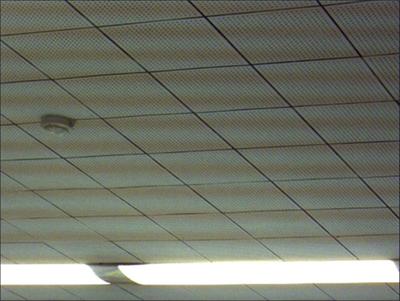
It occurs under lighting that repeatedly emits periodic light, and does not occur in lighting with direct current lighting.
The flicker phenomenon can be suppressed to some extent by adjusting the camera’s exposure time or shutter speed, but it cannot be completely eliminated. Even if the flicker seems to disappear, the light and dark are changing over a long period of tens of seconds or more. Especially when using a high-speed camera under fluorescent lighting, a significant flicker phenomenon occurs.
※ If the shutter speed cannot be adjusted on the camera side, the aperture of the lens can be adjusted to compensate for the lack of illumination with DC lighting to reduce the effect of pulse lighting relatively.
The “flicker-free function” is a function in which the camera automatically detects the flashing of the light source and releases the shutter at a timing that has little effect on the brightness and color tone.
To avoid the flicker phenomenon, use direct current lighting or strobe lighting synchronized with the camera shutter for high-speed camera lighting.
We offer a wide range of high-speed cameras and lighting equipment suitable for those applications, such as high-speed camera lighting and strobe lighting.
If you are suffering from the flicker phenomenon, please feel free to contact us.
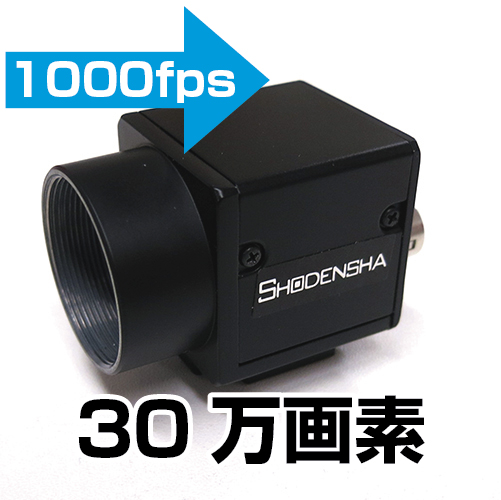 |
Low-cost high-speed camera (Color/ Monochrome) CHU30-C-RS / CHU30-B-RS
|
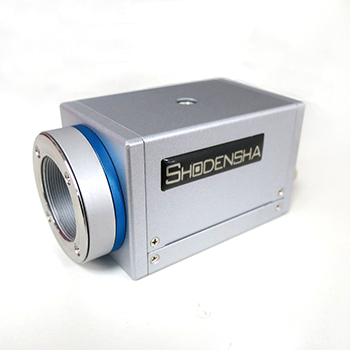 |
High-Speed Camera CHU130EX
|
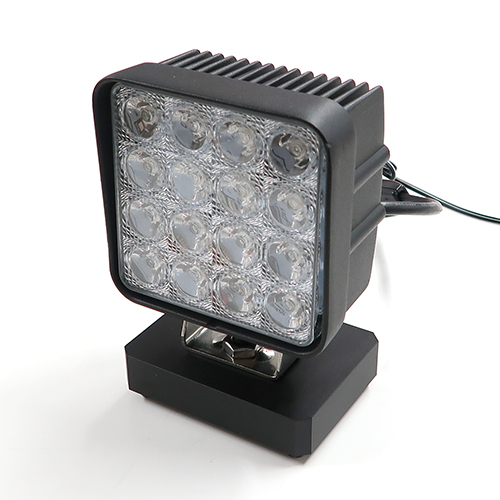 |
Simple Lighting for High-Speed Camera SCH-SN48W
|
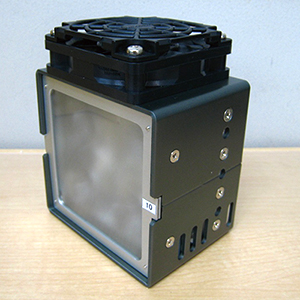 |
Strobe Lighting CH-SN
|
When using a camera with a wide field of view or a long operating distance, the support of the stand may be reflected.
In this case, adding a horizontal stay to a regular camera stand can avoid reflection.
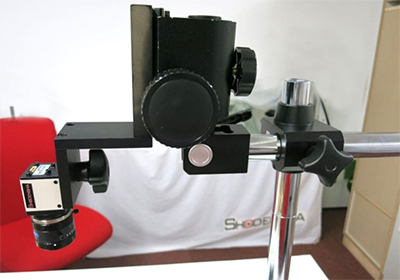
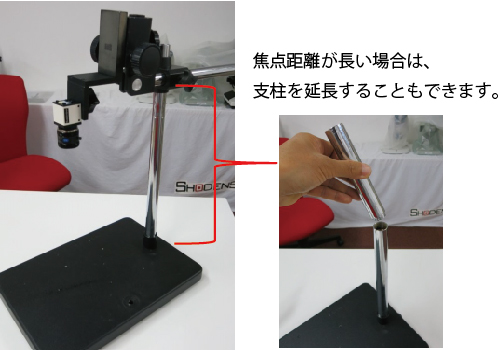
The following camera accessories are also available at camera specialty stores.
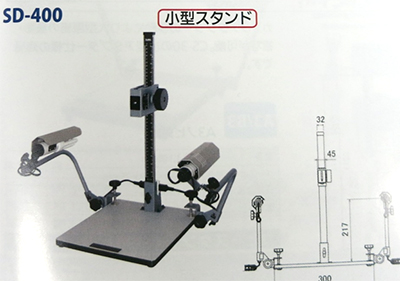
If you would like to know more about our products, please contact our technical support.
The load capacity of the camera angle attached to the end of the flexible arm (FA100-M) manufactured by Shodensha is 5 kg.
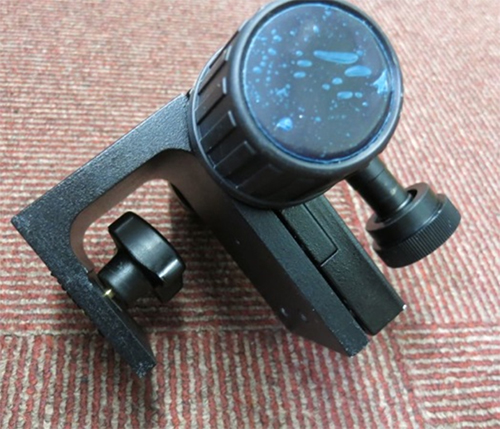
By attaching this to the camera stand, it can be made into a 5 kg load-bearing type.
(A normal camera stand weighs 2 kg.)
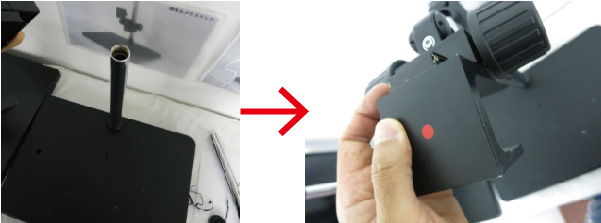
In order to attach the camera angle for flexible arm to a 25mm dia. post, the following parts must be custom-made.
Since they are custom-ordered, the length can be manufactured according to your request.

Production Examples
<Camera stand with a load capacity of 5kg
Camera mounting screws are common in most cases.
In many cases, thermographs and large high-speed cameras also share the same mounting screws.
If you are looking for a stand with a high load capacity, you can easily find one by looking for camera supplies.
Although dedicated equipment may be available, we will introduce an easier and less expensive way to take pictures.
Load capacity 5kg type
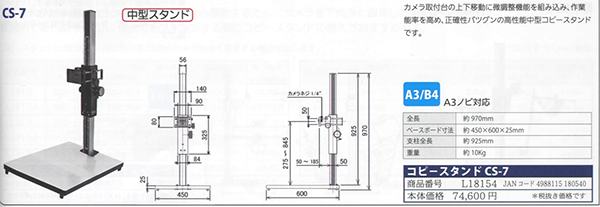
Load capacity 10kg type
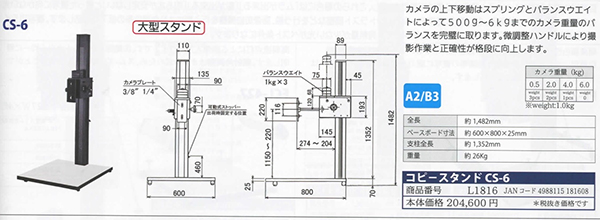
Shodensha also has a custom-made camera stand with a load capacity of 5 kg.
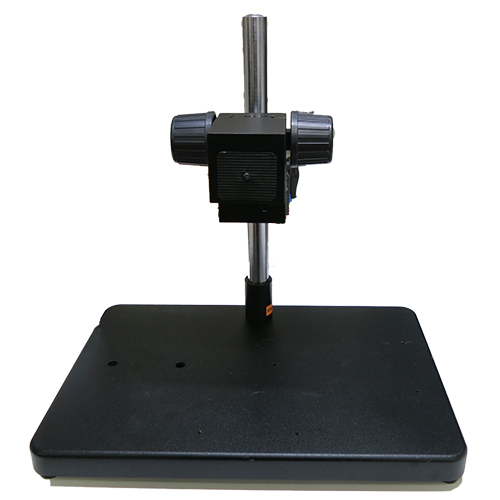
How long do you record for? How will it be stored? Is there a need to remotely view Live video? How many cameras are needed? There are various methods depending on the purpose. There are three main methods.
A camera and a recorder are required, and the camera and recorder are connected to one network. Videos are stored on the recorder. All necessary videos can be saved as data. Basically, Live video can be checked within the network.
| Merit |
|
・Long time recording (e.g. 1 month) ・Multiple cameras (e.g., 16 cameras) can be recorded ・All recorded data can be saved |
| Demerit |
|
・Wiring and setup are complex (generally done by a professional installer). ・Cameras are relatively inexpensive, but recorders are expensive. (Recorder prices vary depending on the number of units and capacity of recorders that can be connected.) ・Cameras are often integrated and lenses are not interchangeable. |
<Examples of commercially available security cameras and recorders>
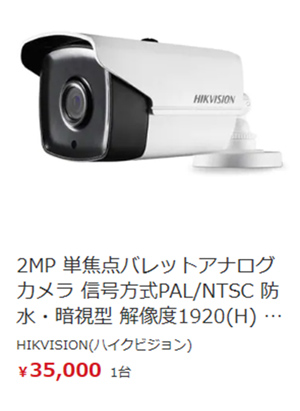 |
|
In this system, you purchase only the camera and pay a monthly fee for cloud usage. Videos are stored on the cloud for a “fixed period of time”. You can watch them as many times as you like within that period. To fully save the video, it must be downloaded, and the downloadable time is determined by the initial contract. You can view the Live video from anywhere with the URL you are given.
| Merit |
|
・Very easy to wire and set up ・Long time recording (e.g. 1 month) is possible ・Capable of recording multiple cameras (16 cameras, etc.) ・Viewing is possible from anywhere with an Internet environment |
| Demerit |
|
・Full storage of recorded data is limited to a certain amount of time ・Lenses cannot be replaced in many integrated cameras ・Security concerns remain |
<An example of a commercially available cloud camera>
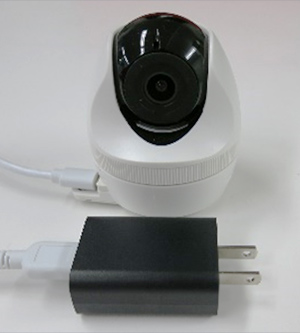 |
|
The camera is not dedicated, but a generic product. It only connects to a PC via LAN or USB and is not connected to a network. Videos are stored on the connected PC or HDD connected to the PC. Live video can be viewed only on the connected PC.
| メリット |
|
・Wiring and setup are very easy (software installation only) ・Lens can be replaced with a general-purpose industrial camera (C-mount) ・By adding software, it can be used in other ways (e.g., recording before and after an abnormal event) ・All data is recorded on a PC, so post-processing (editing) of files can be done with a series of PC operations ・Camera can be downsized |
| デメリット |
|
・The recording time and the number of cameras are limited due to the limited capacity of the PC or HDD. (Những gì chúng tôi có thể cung cấp là camera 1,3 triệu pixel, có thể kết nối với 8 camera và ghi hình 8 giờ mỗi ngày |
Industrial cameras and additional software are available from us.
We sometimes receive requests from customers who want to use a USB camera to “capture and store long videos.” We have received requests from our customers to “record and save long videos” with a USB camera.
In this issue, we would like to introduce several methods for recording long videos with a USB camera.
Our USB 2.0 cameras can record with the included standard-supplied Viewer software, but the AVI file standard for exporting is outdated and a file size limit of 2 Gbytes exists.
If you need a short time, you can use this Viewer software. (In case of 1.3 megapixel type (1280X1024) at 30 fps, it can record for about 15 seconds.)
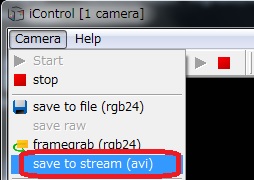
Our USB 2.0 cameras can also be used as DirectShow cameras, so basically you can record with commercial or free recording software that supports DirectShow.
If you have such recording software, you can check if it is possible to record using a demo unit on loan. One well-known free software is “Amcap” provided by Microsoft as a sample program.
(The only saving format is uncompressed (AVI).
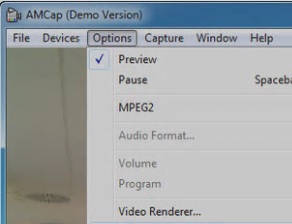
Although not a USB camera, there is also a way to attach a USB 3.0 converter to an HDTV and record for long periods of time on a PC.
All of our HDTV models can record video if you use I-O Data Device’s GV-USB3/HD.
There are a few things to keep in mind when using a PC and a USB camera
for long-duration video recording.
Video data files can be very large.
There are some free video recording software available, but in most cases,
they are uncompressed (AVI files, etc.).
For long time recording, it is necessary to compress the data in H.246 format
or other formats to record for long periods of time.
In the case of 1 hour of recording at 1280 x 1024 (1.3 million pixels) at 30 fps,
the file size is 430 x 430 x 430 pixels (1.3 million pixels) at 30 fps,
・430GB if uncompressed
・If compressed, it will be about 16.5GB.
It is not a problem for about 24 hours, but be careful when the level reaches 3 days, 1 week, etc.
Even if recording can be done, it may not be possible to play it back with general-purpose playback software
such as Windows Multimedia Player.
For example, if you are recording for a week and each day has 8 hours of recording time,
do not batch record and create multiple files for one day (8 hours).
The compression will be 16.5 GB per hour (1.3 megapixels at 30 fps), which is 130 GB for 8 hours.
A week would be divided into 7 files. 130GB x 7 days = 910GB.
This means that 1TB of HDD can be used for recording. If a file is only 130 GB,
it can be played back with Windows multimedia player, etc.
Introducing a useful trigger control software that emits a trigger signal from an external source, such as a program controller (PLC) or sequencer, and uses an embedded USB camera.
①Simple is best light model for still image storage with trigger signal input: Hi TriggerF Light
・Our Hi TriggerF Light can save a still image or capture a screen image (temporary storage) at that moment
by inserting an external trigger signal into the camera.
・Live display is also possible without a trigger signal, making positioning and focusing easy.
・A digital zoom function allows you to enlarge or reduce the camera image to the desired size on your PC screen.
It also has a fit-in function that allows the camera image to fit perfectly on your PC screen.
・The exposure time can be adjusted so that even fast objects can be photographed without blurring.
→Perfect for cases where you only need to save still images with external trigger signal input!
②Middle model with still image storage + cross line display, time stamp, and binarization function with trigger signal input: Hi TriggerF Pro
→Perfect for still image storage with external trigger signal input + plus function!
→Perfect for use with multiple cameras up to 4/8 units!
DirectShow is a multimedia framework and API developed by Microsoft.
A DirectShow-enabled camera is a camera that works with the DirectShow framework.
The DirectShow filter processes the camera data according to the requirements of the DirectShow software, allowing the camera to be controlled by the software.
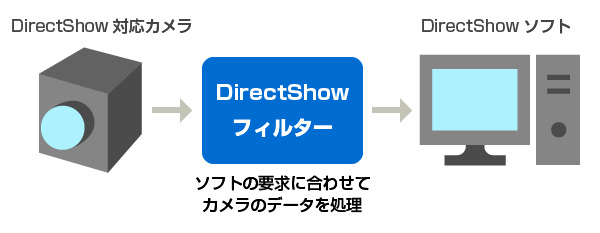
The filter matches the camera and software so that they can work together.
Without the filter, the software cannot properly process the data from the camera.
There are three main causes of problems:
① If a bug exists that prevents the software from properly utilizing the DirectShow framework.
②When the DirectShow filter is unable to process the data output from the camera according to the specifications required by the software.
③Data from the camera does not match the DirectShow filters supported by the software.
In both cases, correcting the respective causes will improve the situation.
(There are compounding factors, so sometimes everything has to be addressed.)
If you cannot use commercially available DirectShow software with our DirectShow-enabled camera, we can provide support such as analysis of the cause if you lend us the software. Please feel free to contact us.
When taking pictures, the camera may make extremely bright areas appear white (halation or blown out highlights), or extremely dark areas may become black and disappear from view (Black Crush).
The range in which the difference in brightness and darkness can be captured at the same time, from one step before halation (overexposure) to one step before blackout (completely dark, unable to see anything), is called the dynamic range. ) is measured.
The wider the dynamic range, the better the camera performance. However, no matter how powerful the camera is, it cannot match the ability of the human eye to capture images. For example, even if a scene is clearly visible to the human eye, when photographed with a camera, it may be overexposed or details may not be visible.
Recently, we have been receiving an increasing number of inquiries about using multiple USB cameras on a single computer at the same time.
I would like to discuss some points to note when constructing it.
If your PC has an available PCI-Express slot, you can add an “expansion board” to increase the number of USB ports (connection ports).
One advantage of this method is that one USB port is used per USB camera, so it is less likely to cause problems such as insufficient communication capacity (bandwidth shortage) of the PC or insufficient power supply from the PC to the USB camera due to the increase in data transmission volume caused by using multiple cameras.
This method is recommended when connecting multiple USB cameras at the same time, since it is less likely to cause problems such as insufficient communication capacity (bandwidth shortage) of the PC or insufficient power supply from the PC to the USB camera.
If three or four USB cameras are to be connected at the same time, we further recommend adding an “Industrial Expansion Board”.
The disadvantages are that the board can be added if there is an available PCI-Express slot in that PC, and that it takes more time and effort to add the board.
Disadvantages include the following.
①Use a USB hub to one USB port on the PC side
Since multiple cameras will be connected, there is a large possibility of “bandwidth shortage,” a shortage of PC communication capacity due to the increase in data transmission volume caused by the use of multiple cameras.。
Compared to adding an expansion board to the desktop to provide additional USB ports, this will further limit the amount of data the camera can use = the number of pixels (resolution) it can use.
②Using a USB hub to connect multiple cameras to a single USB port on the PC side will result in insufficient power supply to the USB camera, which will greatly increase the possibility of not being able to see the image.
The initial setup procedure for recognizing and displaying each camera may become complicated.
③The initial setup procedure for recognizing and displaying each camera may become complicated.
→Please contact our technical department if you would like to use multiple USB cameras for multiple activations. We can propose a total system.
When CMOS sensors first began to be used in cameras, the following differences were recognized between them and CCD sensors.
1. CD provides more natural color reproduction.
2. CCD images are clearer.
On the other hand, it has been pointed out that with CMOS sensors, minute blurring occurs in images and the clarity is poor. .
3. The CMOS sensor uses a rolling shutter method, which tends to cause distortion and afterimages in moving scenes.
There was an impression that early CMOS sensors were of low quality, but as technology advances, the performance of CMOS sensors has improved and is now comparable to CCD sensors. Regarding the difference between CCD and CMOS
1. Occurrence of smear (a phenomenon in which a band of light appears on the image).
2. Often more expensive than CMOS.
3. Power consumption is higher than CMOS sensors, making them unsuitable for battery-powered digital cameras and video cameras.
4. Because it is not possible to read out only a portion of the image sensor, it is difficult to lower the resolution and increase the frame rate.
1. CMOS sensors have an amplifier built into each pixel, which tends to cause certain pattern noise due to variations in performance.
2. The production process for CMOS sensors is similar to that for CPUs and LSIs, and they can be manufactured at lower costs than CCD sensors.
3. CMOS sensors can be operated at lower voltages, which facilitates faster data readout and higher resolution.
4. Because partial readouts are possible, cameras using CMOS sensors can improve frame rates by lowering the resolution.
CCD sensors suffer from smearing, while pattern noise is a major problem with CMOS sensors. However, with improvements in manufacturing technology and noise correction, pattern noise in CMOS sensors is gradually becoming less noticeable.
Also,
CMOS → Rolling shutter → Sensitive to movement
CCD → Global shutter → Strong against movement
Although there was a relationship that was sometimes expressed as “CMOS sensors”, CMOS sensors with global shutters are now being produced.
In the past, CCD was the main focus in device development, but today CMOS has become mainstream, and technological advances are supporting improvements in CMOS performance.
As a result, the idea that CCD is superior to CMOS is no longer universally applicable; image quality and performance vary depending on the type of sensor.
As a result of sensor manufacturers, particularly Sony, discontinuing the production of CCDs, the switch to CMOS is accelerating in fields that traditionally used CCDs.
Shodensha provides cameras equipped with CMOS sensors with global shutter functionality, and supports the smooth transition from CCD to CMOS.
The competitive price of CMOS sensors directly contributes to lower operating costs.
1. CCD sensors are said to have the ability to reproduce more natural colors.
2. The image provided by CCD sensor is clearer. On the other hand, images from CMOS sensors may have minute blurring, which affects the clarity of the image quality.
3. Since the CMOS sensor is based on a rolling shutter method, it has been evaluated as being vulnerable to capturing moving scenes.
However, over time, CMOS technology has improved significantly and now it is comparable to CCD sensors. Therefore, the general idea that CCD is superior to CMOS no longer applies universally, and differences in image quality and performance now depend on the unique characteristics of each sensor. Additionally, CMOS sensors equipped with a global shutter are currently being produced.
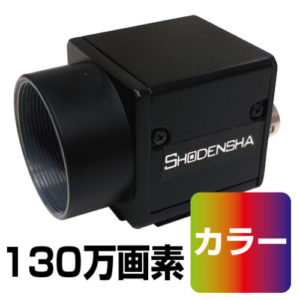 |
USB3 Vision camera (USB3.0, 1.3 MP, color) CS130U-C
USB3 Vision camera (USB3.0, 0.4 MP, color) CS41-C |
|
DirectShow refers to a set of instructions, functions, and norms developed by Microsoft that apply to libraries and programs for video conversion. Quite simply, a DirectShow-enabled camera can be programmatically controlled using common instructions.
This mechanism allows the user to operate the camera through various application software without having to use a dedicated application that comes with the camera when the USB camera is recognized by a PC. However, you may need to take steps to get your PC to recognize the camera, if necessary.
This makes it possible to use a variety of application software from different developers. For example, it is possible to select and use the necessary software according to the application, such as viewer software that simply displays images, software that performs image measurement, software that performs automatic visual inspection, and software that performs 3D image synthesis. There are many companies on the market that only offer software.
However, there are multiple types of video formats that the camera outputs, and the application software used must support these formats.
Video formats include YUY2, RGB24, and RAW16, for example. While the software provided on its own often supports these common video formats, some software shipped with the camera only supports specific camera-specific formats.
USB Video Class (UVC) is a generic standard name for camera devices connected via USB. Current Linux and Windows systems already include drivers for UVC, so no additional driver installation is required.
This also refers to these cameras as installation-free cameras or driver-free cameras.
In contrast, many industrial cameras require manufacturer-specific drivers, which require the application to install driver software separately.
Below is a list of advantages and disadvantages of UVC cameras.
(1) On Linux and Windows, even between different camera brands, if you use a UVC camera, you can program with almost the same coding.
This eliminates the need to learn the SDK for each camera brand separately.
(2) There are very affordable models of UVC cameras, which make it possible to build a system at a low cost.
(3) In both Linux and Windows environments, you can easily acquire video using the VideoCapture class of OpenCV (OpenCV Sharp, OpenCV-Python).
(1) There are few UVC cameras that support external triggering, because the UVC standard does not take into account shooting with external triggers. This is especially true when you want to shoot with a signal from an external PLC (sequencer) or sensor.
*Shodensha has added a UVC camera that can be connected to an external trigger to its lineup. Please contact us for more information.
(2) For most UVC cameras, even if you set detailed settings such as brightness, color, and shutter speed, these settings will be reset when the power is turned off.
Therefore, these settings must be recorded separately by the program and reapplied when the camera restarts.
In contrast, many industrial cameras allow you to save the settings in the camera, and even after the power is turned off, it automatically returns to the previous settings when the power is switched back on.
*Shodensha offers a special UVC camera that allows users to precisely adjust and store the white balance. Please contact us for more information.
(3) UVC cameras have the advantage of being able to easily acquire images using OpenCV, but the current OpenCV (as of version 4.5.2) does not have a function to fine-tune the white balance.
This can be a major barrier, especially in tonal applications.
This is not a limitation of the UVC camera itself, but a problem caused by the lack of functionality of OpenCV.
*In order to meet these needs, Shodensha provides UVC cameras that can finely adjust the white balance and save the settings. Please contact us for more information.
(4) When multiple UVC cameras are used on one PC at the same time, it is possible to obtain the image output from each camera, but since it is not possible to distinguish between individual cameras, the image display position may change every time the PC is restarted.
For this reason, if you are considering the simultaneous use of several cameras, we recommend that you use a regular industrial camera.
There is no external trigger terminal, and although you can adjust brightness, color, and shutter speed using the Viewer software, these settings are reset when the power is turned off. This series is a cost-conscious choice.
It is equipped with an external trigger terminal and includes a tool program that allows detailed white balance settings and their storage using OpenCV.
This series has features that compensate for the typical limitations of UVC cameras and is designed for industrial applications.
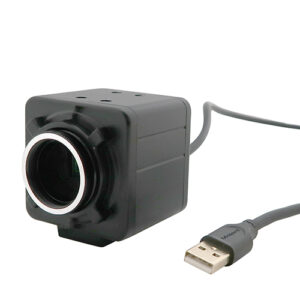 |
C-mount type low-priced UVC camera series (WA2 series) |
 |
C-mount type industrial UVC camera series (DN series) |
VC cameras are also called “driver-free cameras” or “installation-free cameras” because they utilize drivers built into the operating system. Its main advantage is ease of implementation.
However, on the other hand, there are drawbacks such as “the white balance cannot be adjusted and saved” and “it does not support external trigger signals.”
Shodensha offers UVC cameras that solve these problems. Please feel free to visit our homepage.
Welding is an important means of bonding metals, and the weld part is very important because it is directly related to the safety of the product.
Therefore, the amount of penetration of the weld is inspected, i.e. dimensional measurements are taken to confirm the depth and quality of penetration. Identify problems such as insufficient penetration, incomplete weld fusion, gaps, and excessive swelling.
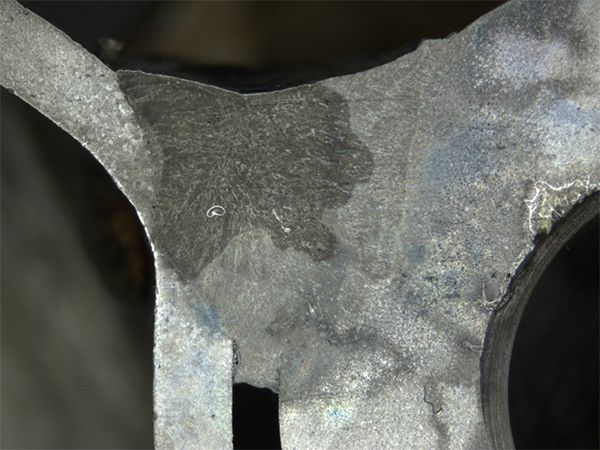
In order to properly inspect the penetration in the cross-section of the weld, the following pre-treatment is required:
① Cutting the test part
② Polishing the cross-section
③ Etching treatment with chemicals or electrolysis according to the material
After these pre-treatments, observations and dimensional measurements are carried out. These preparatory tasks are often entrusted to specialists, but this time we will present a product that specializes in dimensional measurement of the amount of penetration of welds.
Specifically, we used our microscope to capture and dimension measurements.
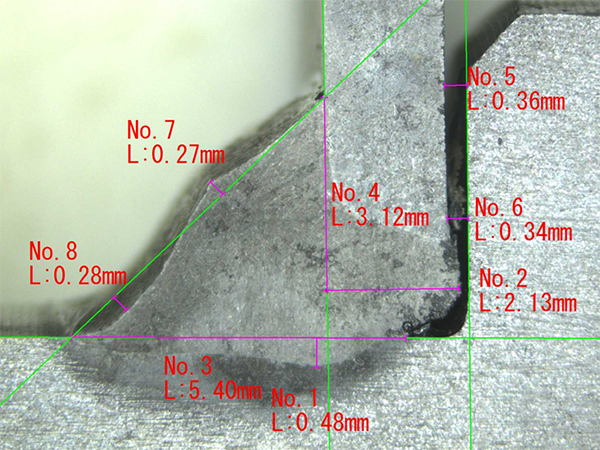
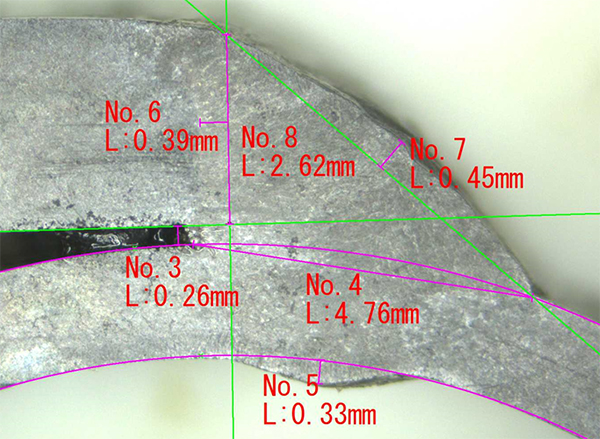
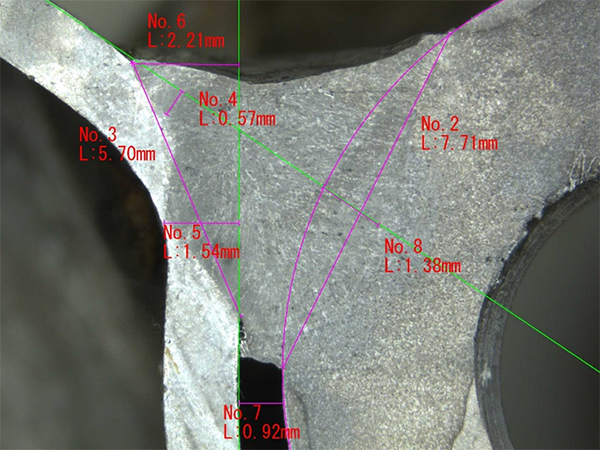
In this process, you need to repeat the following steps:
● Generate a reference line
● Measure the distance from the intersection of the reference lines
●Generate parallel lines
● Measure the vertical distance from the reference line
When dealing with a large number of specimens, this task can be quite time-consuming.
However, when using our measurement software, the following measurement support functions are enhanced, and it is possible to improve the efficiency of the time-consuming measurement work of the amount of weld penetration.
By clicking the mouse on the screen, a cross line will appear at any position.
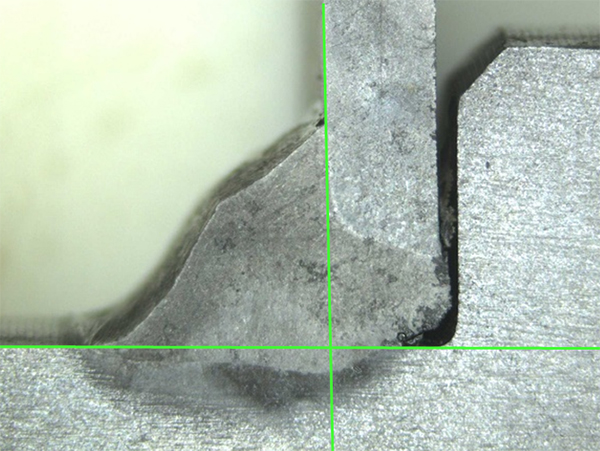 |
If the position is misaligned, you can easily repeat the click to adjust the position. |
It is equipped with a wide range of measurement functions and can be used not only for measurement tasks, but also as a reference line.
In this case, you can set the display of the measured value to be hidden.
This feature is particularly useful for measuring “vertical distances”.
In addition, the display color of each measuring line or numerical value can be changed individually.
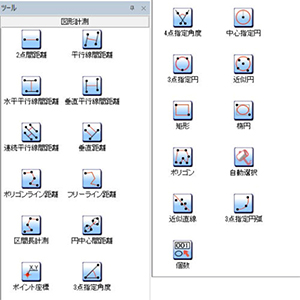 |
● Distance between two points ● Distance between parallel lines ● Horizontal parallel distance ● Vertical parallel line distance ● Vertical distance ● Distance between the centers of the circle ● Point coordinates ● 3 point specified angle ● 4 points specified angle ● 3 points designated circle ● Approximate circle ●Rectangle ● Ellipse ● Approximate straight line ●Three-point arc etc |
When the mouse cursor is brought close to the desired measurement line, edge detection is automatically performed and the cursor fits the line.
This minimizes errors during the measurement process and results in more accurate measurements.

You can use the mouse wheel to digitally zoom around the position that the cursor is pointing to.
This allows for intuitive scaling and further reduction of measurement errors.

You can display the scale at any position at the desired size.
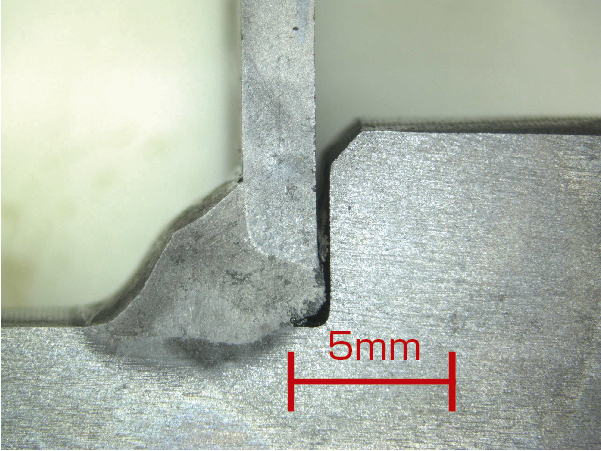
Simply click the Print to Excel button to transfer the measurement data to Excel. This makes it easier to process data and create charts in Excel, which helps reduce reporting time.
It is very convenient to output raw images, images with measured values, and measurement values to Excel at once.
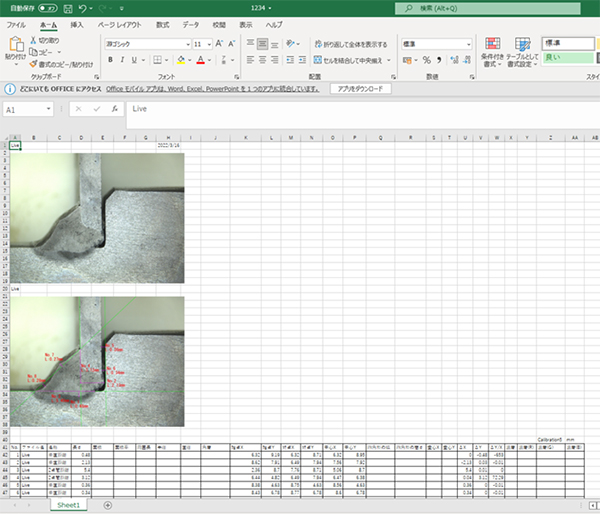
This is the measurement software used this time
| ● High-performance image processing measurement software MF Ship | 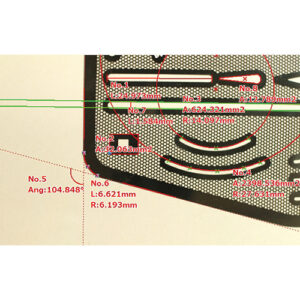 |
This is the microscope used this time
| ● USB3.0 Microscope TG500CS | 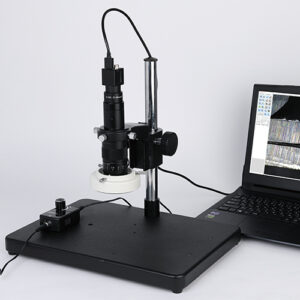 |
Our GRAV-1 video recorder offers the ability to store video data using a USB memory.
The device supports USB flash drives with a capacity of up to 32 GB and uses FAT32 format. It is possible to save image files in JPEG or BITMAP format. Especially in the case of jpeg format, the file size per sheet is about 100 KB.
Theoretically, up to 320,000 images can be stored.
However, the FAT32 format has a limit on the number of files, and the maximum number of files that can be stored in the root directory is about 65,000.
As a result, even if there is plenty of space, the number of images that can be stored is limited to 65,000.
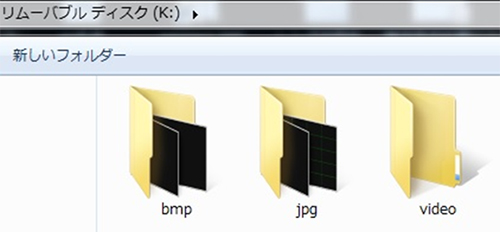
To deal with this problem, the GR-AV1 automatically creates three folders and stores files in these folders in order.
However, it is not possible to change the directory structure, and therefore will continue to be affected by the file limit described above.
7 segments compatible !
Can be attached directly to a lens with a coaxial unit !
● Light intensity can be visualized with 7 segments display
● With RS232 terminal that can be controlled by a computer (SDK included)
● Since the tip is general-purpose φ8mm, it can be directly attached to a lens with a coaxial unit.
● 2m extension cable (lighting ~ power supply) included as standard
When using a stand, you may find yourself in a situation where you want to adjust the distance to the object you are observing. This refers to when you want to get closer to an object or conversely, when you want to keep a distance. In addition, if you are wearing other accessories, these may interfere with each other.
In fact, on a large number of stands, it is possible to mount the angles upside down. (Of course, the stand provided by our company can also be mounted upside down.)
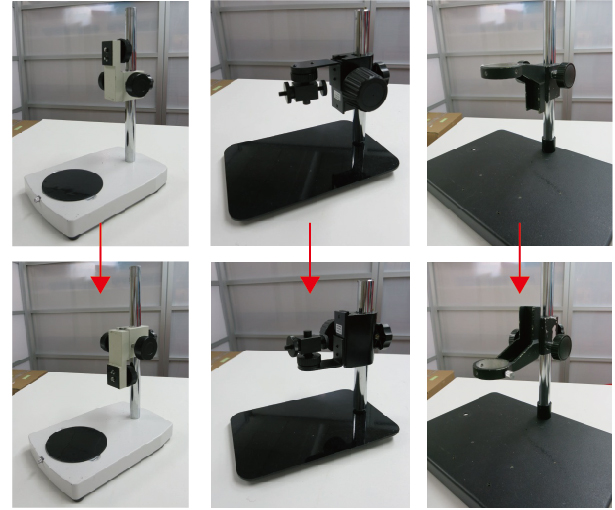
■ Useful when interference with other accessories is a problem.
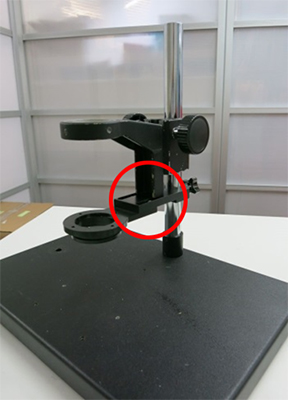 |
|
| Reversing the angle may solve the interference problem. | |
 |
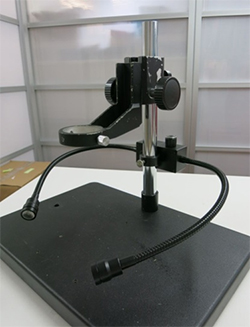 |
| Example of using a standard stand (GR-STD4) and an LED angle (LED-A2) | Example of using a standard stand (GR-STD4) and flexible LED spot lighting (SPF-FL3) |
|
|
|
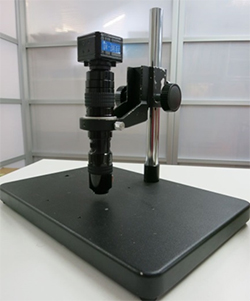 |
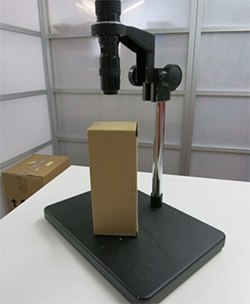 |
If you are looking for an affordable and relatively advanced microscope, we recommend the DS-PC4 (USB microscope) and DS-70TV4 (video microscope). These microscopes have limited zoom capabilities and do not allow the use of auxiliary lenses, but they are a very cost-effective option if they meet your requirements.
In particular, the DS-70TV4 is a great help because it can be carried with a portable video recorder with a monitor to perform observation tasks anywhere.
|
LEDintegrated
5MP USB microscope DS-PC4 |
LEDintegrated
Video microscope DS-70TV4 |
Here are two effective methods for combating halation.
1.How to use polarizing filtersBy superimposing polarizing filters, it is an effective way to reduce halation. (A detailed explanation of this method can be found in “Fundamentals of Polarization Observation.”) |
|
<Example 1: Solder point of electronic board >This method reduces the reflection of light in the solder. |
|
 |
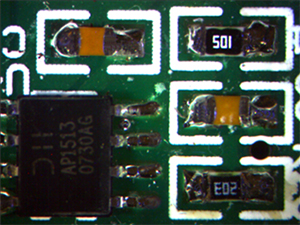 |
| <Before halation suppression> | <After halation suppression> |
<Example 2: Film>I was able to erase the reflection of light on the film. |
|
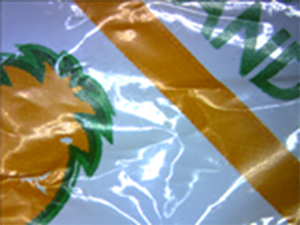 |
 |
| <Before halation suppression> | <After halation suppression> |
<Example 3: IC storage stick>It reduces the surface reflection of the stick and makes the IC characters clearly readable. |
|
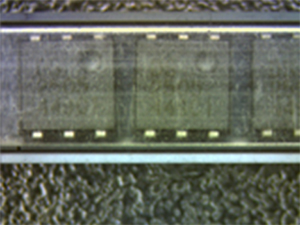 |
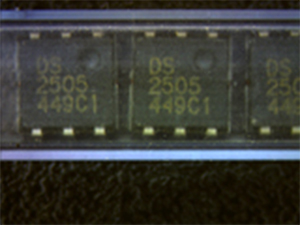 |
| <Before halation suppression> | <After halation suppression> |
|
<Example 4: Printing an IC> |
|
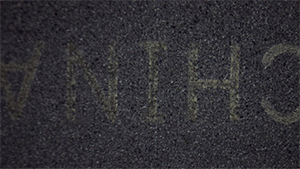 |
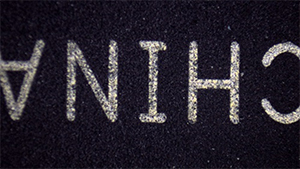 |
| <Before halation suppression> | <After halation suppression> |
|
<Example 5: Soldering> |
|
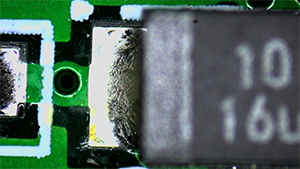 |
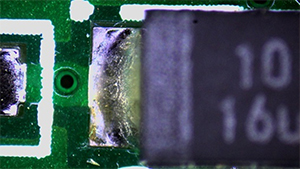 |
| <Before halation suppression> | <After halation suppression> |
|
<Example 6: An object with a mixture of high and low reflectivity> |
|
 |
 |
| <Before halation suppression> | <After halation suppression> |
|
<Example 7: Printing on Film> |
|
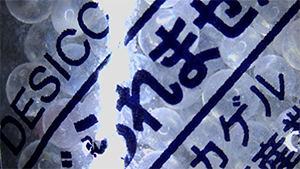 |
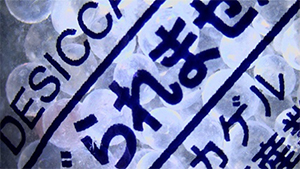 |
| <Before halation suppression> | <After halation suppression> |
|
<Example 8: Object in a plastic bag> |
|
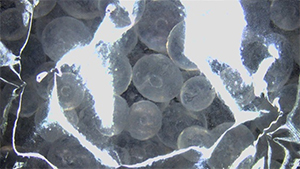 |
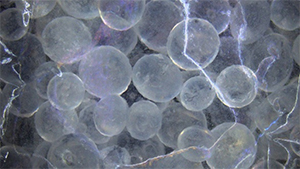 |
| <Before halation suppression> | <After halation suppression> |
|
<Example 9: Convex character of white resin (embossed part)> |
|
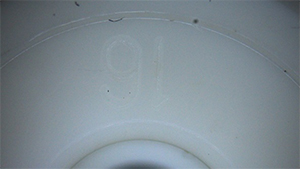 |
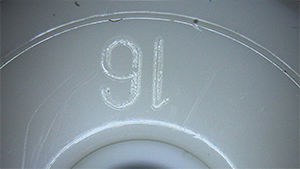 |
| <Before halation suppression> | <After halation suppression> |
2.Take advantage of high dynamic range (HDR) capabilitiesThis feature uses a technique that extends the sensitivity range of the sensor at the expense of some of the contrast. This feature is available on our C-mount HDTVs. |
|
<Example 4: Screw axis> |
|
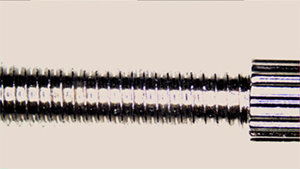 |
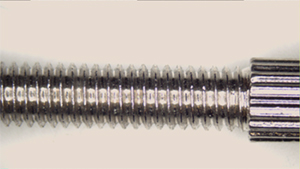 |
| <Normal shooting mode> | <HDR shooting mode> |
 |
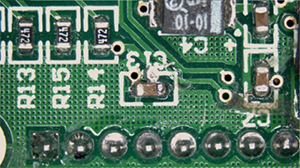 |
| <Normal shooting mode> | <HDR shooting mode> |
We will be happy to suggest a solution suitable for your specific needs, so please contact Technical Support for more information.